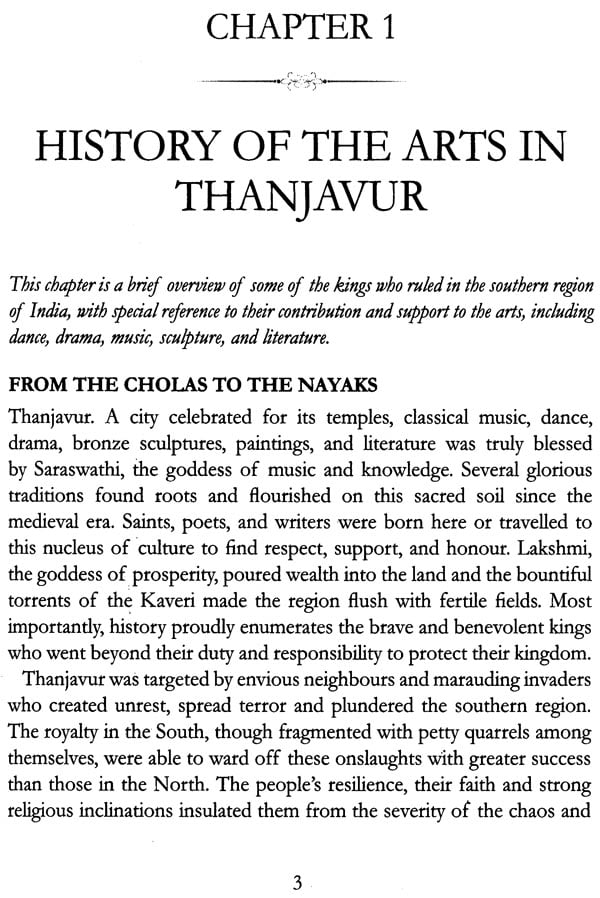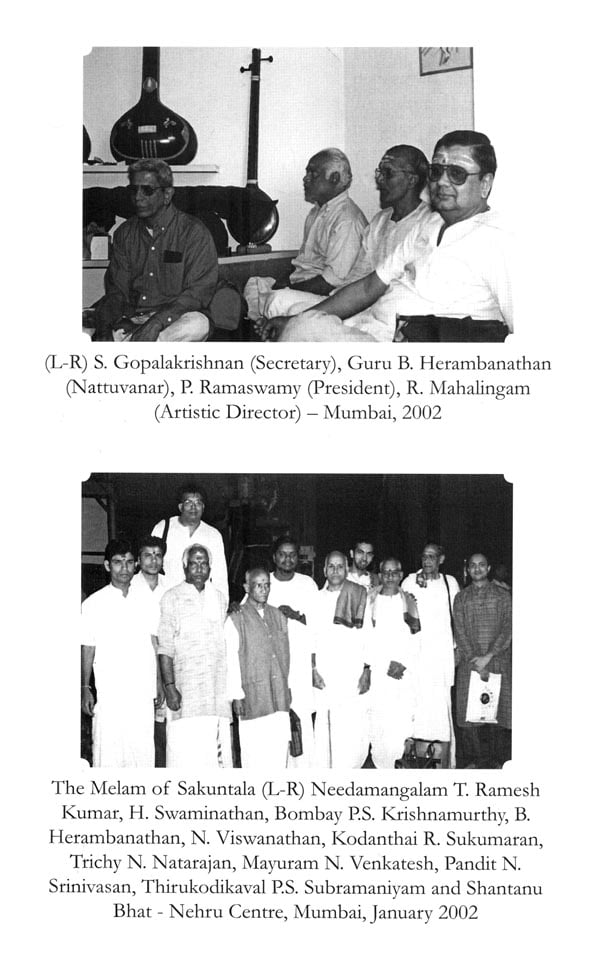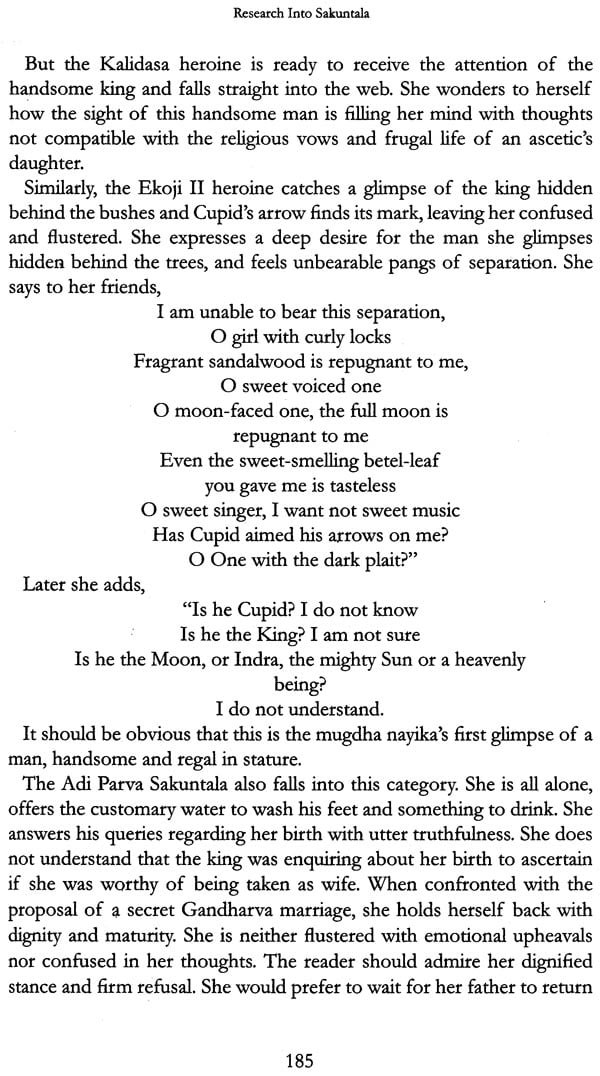
Bhagavata Mela (My Tryst With Tradition)
Book Specification
| Item Code: | NAO940 |
| Author: | Indumati Raman |
| Publisher: | Indus Source Books |
| Language: | English |
| Edition: | 2018 |
| ISBN: | 9789385509087 |
| Pages: | 318 (32 B/W & 32 Color Illustrations) |
| Cover: | Hardcover |
| Other Details | 9.0 inch X 6.0 inch |
| Weight | 580 gm |
Book Description
Deep in the interior of Thanjavur, South India, is a small village called Melattur, rich with traditions of rituals, dance, music, and theatre. The male Brahmin priests of the Sri Varadaraja Perumal temple perform classical dance to chaste Carnatic music enacting various divine stories of Vishnu. Bhagavata Mela's unique feature is that all artistes are male, including the dancers for female roles. They keep alive a 500-year old heritage handed down by their forefathers. Melattur Venkatrama Sastri has written twelve plays in the Telugu language. Narasimha, the fourth Avatar of Vishnu, holds special significance to these Brahmin Bhagavatars. Every year on Narasimha Jayanti, which falls in the months of April/May, the native sons of Melattur gather here to celebrate the festival with a performance of Prahlada Charitram, the story of the Manifestation of the Avatar.
In the temple, a three-hundred-year-old mask of Narasimha is worshipped through the year. On the Narasimha Jayanti day, it is taken out and worn by the actor who is privileged to play the role of Narasimha.
Tradition is what we receive from our ancestors and hand down to posterity. Bhagavata Mela exists in Saliyamangalam, Teperumalnallur and Melattur. Every family offers one son to the tradition. As a child, he is trained in classical dance, speech and movement. The foundation of this art is unshakeably set in religious fervour and ritual. It is a community festival and a religious duty to continue this tradition.
The Bhagavatars have kept alive the tradition known to exist from the Chola era, resisting radical changes in society, and are persevering to nurture it.
There is very little historical material published on Bhagavata Mela. This book is a compilation of research during the author's ten-year association with the gurus, artistes, musicians and pandits of the Melattur Bhagavatha Mela Natya Vidya Sangam. This is the first step to document all aspects of the tradition in one book.
Bhagavata Mela: My Tryst with Tradition scans the history and evolution of the Bhagavata Mela tradition. The scholarly Nayaks and the Maratha kings of Thanjavur honoured the artistes and penned Bhagavata Mela natakams in Telugu, Sanskrit and Marathi.
The book also describes the privileged journey of the author who, with the cooperation of the Melattur artistes, helped to focus the limelight on Bhagavata Mela.
In 2002, Bavasaheb Ekoji II's natakam Sakuntala was produced, directed and staged in Mumbai by Indumati Raman in collaboration with artistes from both Melattur and Mumbai. The effort received acclaim and appreciation from the Marathi theatre fraternity in Mumbai.
Indumati Raman, an alumna of Rukmini Devi's Kalakshetra (Chennai), is a dancer, teacher, choreographer and writer who worked from 1993 to 2002 with the artistes of Melattur Bhagavata Mela Natya Vidya Sangam as Chairperson, Sponsor and Patron.
In May 1993, I went on a voyage of discovery. I went to Melattur with Indumati Raman and her parents to see a performance of the Bhagavata Mela Natakam Prahlada Charitram. This and other Bhagavata Mela plays are performed annually on Narasimha Jayanti as a devotional offering to Lord Vishnu, on a provisional stage erected directly in front of the Sri Varadaraja Perumal temple. The entire village from babes-in-arms to venerable elders turns up to watch.
The opportunity to see a Bhagavata Mela performance in one of its six traditional homes answered a long-cherished wish of mine. My interest in it arose from the fact that this music, dance and theatre form is deeply embedded in the history of Marathi drama. It is recorded that the Raja of Sangli, Chintamanrao Patwardhan (1782 - 1851) chanced to see a Bhagavata Mela performance and was so impressed by it that he instantly instructed a young engineer-puppeteer-mask maker of his court, Vishnudas Bhave, to create a similar play to entertain and edify his courtiers. Bhave set to work. He trained a group of Brahmin cooks and food-and-water servers to speak sing and act. The play he wrote and directed, Sita Swayamvar, was performed at the Sangli court in 1842. It was very successful and many more such plays followed, making Bhave the father of Marathi theatre which has an unbroken history today of 174 years.
The only element missing in Sita Swayamvar which would have been an integral part of any Bhagavata Mela play, was dance. The story goes that Chintamanrao had asked Bhave to make a more "refined" version of a Bhagavata Mela play by dropping dance. However, I would like to propose another equally likely reason for the absence of dance in Bhave's play. While a group of non-actors can be taught, at a pinch, to speak and sing, they cannot be taught to dance. That calls for long years of training with a guru from a very young age. Given that dance had not been part of Maharashtra's performing arts culture as theatre and music were, it could not be suddenly produced for a play. Consequently, Sita Swayamvar and the plays it spawned had no dance, only a few simple, rhythmic steps.
Although Balwant Gargi's note on Bhagavata Mela, appended to the main body of his useful book Folk Theatre of India, provides a brief but accurate description of the form, his placing it in the context of folk theatre forms like Nautanki, Bhavai and Tamasha, had misled me into believing it was light entertainment, albeit inspired by bhakti. I cannot describe how astonished I was to see the performance at Melattur. I remember turning to Indu at the end of the performance and exclaiming, "But this music and dance are pure classical!" What further astonished me was to learn that in this day and age, men continued to play the female roles. Indeed, tradition forbade women from participating in Bhagavata Mela. It also forbade men from castes other than Brahmin from participating. To complete my astonishment, I gathered that almost all the actors whom I had seen perform that night, belonged to families which had been acting in Bhagavata Melas for generations. Although these men—engineers, clerks, teachers—no longer lived in Melattur, they returned faithfully to the village every year to rehearse and perform for the Narasimha Jayanti Utsay.
This first-hand experience of seeing Bhagavata Mela could not have come to me at a more opportune time than May 1993, for I was deep into researching my book Playwright at the Centre: Marathi Drama from 1843 to the Present at the time. This was the project for which I had quit my job as Arts Editor of the Times of India, Mumbai. I must confess, I had gone to Melattur with a typical city-dweller's idea of a "folk performance". It was a somewhat romantic notion which was destroyed in the course of the two days we spent in Melattur when I realised that to keep a 400-year-old tradition alive in its pristine form through a history of Muslim invasions and British colonisation was not some airy-fairy affair, but something that required profound faith and gritty determination.
My experience of Melattur Bhagavata Mela was further enriched by the visit we made to the Sarasvati Mahal library where palm leaf manuscripts of plays written by the Maratha kings of Thanjavur were carefully preserved. I was moved by the creative openness of those old kings who wrote plays in the Bhagavata Mela form which was culturally alien to them but which they had made their own. What a contrast I thought to the present rulers of Maharashtra who took a perverse pride in the acute narrowing of their cultural vision.
Returning to Mumbai after that visit to Melattur, I was witness to Indu's passionate involvement in putting Bhagavata Mela back on the dance theatre map of India. For nine years, she thought only of Bhagavata Mela and how she could help the Melattur group to continue and strengthen their work. Before her was a dream which she managed to realize in 2002. As a culmination to her great efforts for Bhagavata Mela and her wish to reforge the links that had once existed between Marathi and Telugu-Tamil, she organised an amazing performance of the Marathi Bhagavata Mela play, Sakuntalam in Mumbai. I, along with hundreds of Marathi theatre aficionados, saw and applauded it.
I knew Indu had worked hard at this production, but it was only after reading an account of it in this informative and lucidly written history of Bhagavata Mela that I realised how hard the work had been and what a diversity of creative talents were brought together to make it the success it was. For me, a voyage which began in May 1993, has been completed in 2016 with the reading of Indu's book cover to cover. The exhaustive story of the 400-year-old tradition of Bhagavata Mela is now in my possession.
Contents
| Acknowledgements | ||
| Importance of Sarvato Bhadra Chakra : | x | |
| Author's Note | xii | |
| Foreword | xvi | |
| PART ONE | ||
| 1 | HISTORY OF THE ARTS IN THANJAVUR | 3 |
| From the Cholas to the Nayaks | 3 | |
| The Thanjavur Maratha Kings | 18 | |
| 2 | BHARATA'S NATYA SASTRA | 39 |
| 3 | THEATRE | 43 |
| The Dramatic Art by F.G. Natesa Iyer | 43 | |
| Religious Rituals and Theatre | 57 | |
| The Mask in World Theatre | 68 | |
| 4 | DANCE FROM SADIR TO BHARATA NATYAM | 82 |
| The Devadasi Heritage | 82 | |
| E. Krishna Iyer | 95 | |
| 5 | BHAGAVATA MELA | 98 |
| From Sanskrit Theatre to Bhagavata Mela | 98 | |
| Bhagavata Mela in the Last Century | 106 | |
| Prahlada Charitram | 126 | |
| Synopses of Natakams by Melattur Venkatarama Sastri | 136 | |
| Saliyamangalam—The Village Tradition | 143 | |
| Bhagavata Mela and Kuchipudi | 155 | |
| PART TWO | ||
| 6 | MARATHI NATAKAMS | 165 |
| Five Marathi Natakams—Synopses | 165 | |
| 7 | RESEARCH INTO SAKUNTALA | 168 |
| Sakuntala in Adi Parva of Mahabharata | 168 | |
| Kalidasa's Abhijnana Sakuntala | 172 | |
| Bavasaheb Ekoji II's Sakuntala Natak | 178 | |
| Veda Vyasa, Kalidasa and Ekoji II—A Comparative Study | 180 | |
| Dhruvas, Poetic and Literary Devices of Bhagavata Mela | 189 | |
| PART THREE | ||
| 8 | MY TRYST WITH TRADITION | 199 |
| To the Manner Born | 199 | |
| Kalakshetra | 201 | |
| Stepping Stones | 203 | |
| 9 | JOURNEY WITH BHAGAVATA MELA | 206 |
| A Decade of Support and Collaboration 1992-2002 | 206 | |
| Revival and Preservation of Traditional Arts | 215 | |
| 10 | SAKUNTALA—THE MAKING | 227 |
| Selection of the Play | 227 | |
| An Auspicious Start | 231 | |
| The Music Composer | 232 | |
| The Natakam Begins | 238 | |
| Final Selection of Ragas | 244 | |
| Costume | 246 | |
| Art Design | 248 | |
| Training and Rehearsals | 249 | |
| The Mumbai Team | 252 | |
| The Mumbai Team | 254 | |
| 11 | The Mumbai Team | 258 |
| 12 | Chronological Flow of the Play | 274 |
| Appendix: | ||
| Cast of Actors and Musicians for the Premiere in 2002 | 275 | |
| A Decade with Melattur Bhagavata Mela Natya Vidya Sangam | 290 | |
| References | 294 |
Sample Pages









